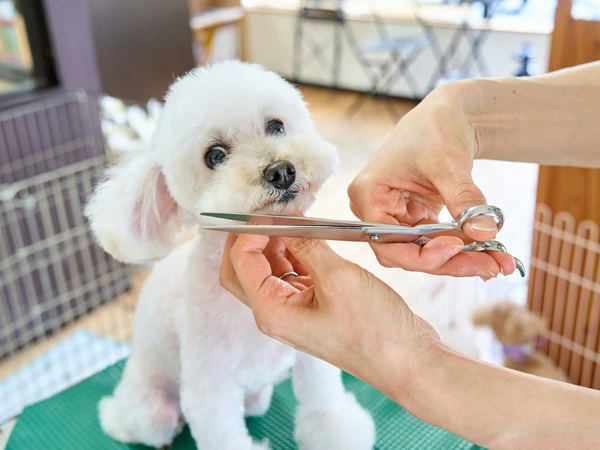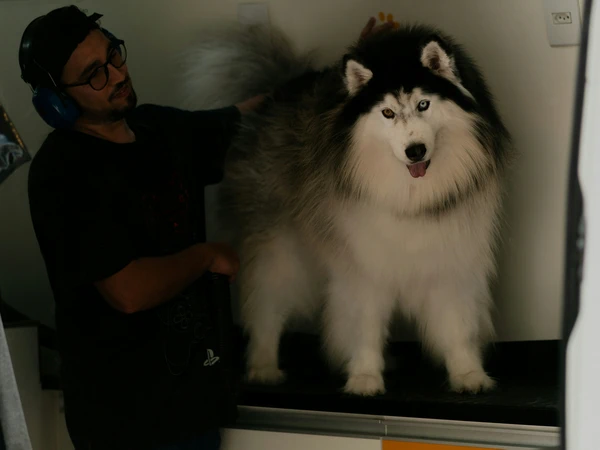Proper pet grooming is essential for keeping your dog or cat healthy, comfortable, and looking their best. Regular grooming goes beyond a shiny coat—it helps prevent matting, reduces shedding, improves skin health, and even allows early detection of potential health issues. In this Pet Grooming FAQs guide, we’ll answer the most common questions pet owners ask, including how often pets should be groomed, what services a professional groomer provides, and tips for at-home grooming. Whether you’re considering mobile pet grooming for convenience or looking for professional grooming tips, this resource will help you create the best grooming routine for your furry friend.
How often should I groom my pet?
There’s no single schedule that works for every pet—it depends on breed, coat type, and lifestyle. In general, most dogs do well with a bath about once a month and regular brushing to control shedding and prevent matting. Long-haired or double-coated breeds may need brushing several times a week, while short-coated dogs can often get by with less. Puppies benefit from visiting a groomer every 2–3 weeks to build positive habits early.
For more detailed coat-specific guidance, check out this helpful pet grooming schedule guide
At what age should I start grooming my pet?
You can begin introducing your puppy to grooming as early as 8 weeks old, but the first visits should be short and simple—things like a bath, nail trim, and light work on the face, feet, and sanitary areas. A full haircut too soon can overwhelm a young pup and create a negative association with grooming.

Most professional groomers prefer to wait until a puppy has received its core vaccinations (around 16 weeks) before scheduling full services. In the meantime, you can help your puppy get ready by gently handling their paws, ears, and muzzle at home so they’re more comfortable when it’s time for a real appointment.
Many salons also offer “puppy grooms” or “puppy cuts,” which are designed to help young dogs get used to the sights, sounds, and handling of the grooming process without the stress of a full session. Starting early builds trust, reduces anxiety, and sets the stage for a lifetime of positive grooming experiences.
💡 Pro Tip: Spend a few minutes each day touching your puppy’s paws, ears, and face. This simple habit will make nail trims, ear cleanings, and future grooming visits much smoother.
What if my pet is anxious or fearful of grooming?
Many pets experience anxiety or fear during grooming, but with patience and the right approach, most dogs can learn to tolerate—or even enjoy—the process. Start at home by desensitizing your pet to the tools and sensations they’ll encounter. For example, using a cheap electric toothbrush on the flat side can mimic the vibration of clippers. Gently touch the face, paws, and legs while rewarding calm behavior to build positive associations.
When choosing a groomer, look for someone experienced with anxious or fearful dogs. A patient groomer who understands behavior and communicates calmly is much more effective than one who seems frustrated or overly apologetic. Consistency is key—staying with the same groomer helps your pet form trust and feel safe over time.
For dogs with extreme anxiety, a vet groomer may be an option. Sedation is only used when necessary, and some dogs may benefit from short-term anti-anxiety medications under veterinary guidance. Simple strategies like muzzle training and helping your dog get onto the grooming table yourself can also reduce stress and improve cooperation.
With gradual, positive exposure at home and supportive handling at the salon, many fearful pets make remarkable progress. Even severe nail or bath phobias can improve with consistent, patient practice.
Can mobile grooming really replace the salon?
Mobile grooming offers many advantages over traditional salon grooming, but whether it can fully replace a salon depends on your pet’s needs.
Convenience and Time-Saving: Mobile grooming comes to you, eliminating trips to the salon and saving valuable time for busy pet owners.
Personalized Attention: Your pet receives the groomer’s full focus, unlike in a salon where multiple pets are handled simultaneously. This ensures one-on-one care and a more attentive experience.
Stress-Free Environment: Grooming in a familiar setting reduces anxiety, especially for senior or nervous pets. Without the distractions of other animals, noisy salons, or travel stress, pets often stay calmer and enjoy the process.

Health and Safety Benefits: Mobile grooming avoids exposure to other animals, reducing the risk of illness or scuffles common in traditional salons.
Professional Service and Flexibility: Mobile groomers come equipped with professional tools and products and can often accommodate flexible appointment times that salons cannot.
Considerations: Mobile grooming can be more expensive than salon grooming due to its convenience and personalized service. Space limitations may restrict some specialized services, and very large dogs or pets requiring complex treatments might be better suited to a full salon. Pets that enjoy socializing with other animals may miss out on the interaction a salon provides.
Overall, mobile grooming is an excellent option for personalized, low-stress care and can complement—or even replace—traditional salon grooming for many pets, especially those who thrive on one-on-one attention.
💡 Pro Tip: If your pet is anxious or elderly, try mobile grooming first. It often provides a calmer, safer, and more enjoyable experience than a busy salon.
How do I know if grooming products are safe for my pet?
When choosing grooming products, look for labels that indicate they are pH balanced for dogs, sulfate-free, paraben-free, and free of artificial fragrances or colorants. These factors help protect your pet’s skin and coat while minimizing the risk of irritation.
It’s also important to consider how often you bathe your pet. Many dogs, especially those with short or weather-resistant coats, require fewer baths than you might expect. For quick clean-ups between full baths, waterless or spray-on shampoos can be a convenient and safe option.
Transparency matters: products that clearly list ingredients—and ideally are cruelty-free—allow you to make informed decisions about what you’re putting on your pet. Trusted brands, like EZ Groom Pro and Earthbath, offer high-quality formulations suitable for different coat types, including high-maintenance or curly coats.
You can check out The Eco-Friendly Side of Mobile Pet Grooming for further information.
What should I do about mats, shedding, or odors?
Get them used to being groomed immediately. My biggest regret with mine is how much he Managing mats, shedding, and odors starts with a consistent grooming routine tailored to your dog’s coat type. Daily brushing is ideal for high-shedding breeds or long-haired dogs. Tools like a slicker brush, regular hairbrush, or a Furminator can help remove loose hair, while de-shedding sprays or shampoos (like Burt’s Bees) make the process even easier. For dogs who resist brushing, short, gentle sessions combined with positive reinforcement can help reduce stress.
Bathing frequency varies depending on your pet, but many dogs do well with a bath every 2–4 weeks. Using a de-shedding shampoo and drying with a blow dryer can help remove loose fur and reduce odor. Most odors are temporary, often limited to the classic “wet dog” smell.
When it comes to mats, the safest approach is gradual detangling with a comb, or carefully cutting them out if they’re severe. Avoid pulling or yanking on mats, as this can injure your pet’s skin. In extreme cases, a professional groomer may recommend trimming the coat to start fresh. Exceptional groomers can sometimes remove mats using conditioner and blow-drying techniques, but this requires skill and experience.
Do cats really need grooming?
It depends on the cat! Most short-haired cats groom themselves well and rarely need baths, except in unusual situations where they get into a messy or hazardous substance. Long-haired cats, however, often benefit from regular brushing to prevent mats, tangles, and hairballs. Some may also need a sanitary trim or occasional trimming around the mane if their fur interferes with eating or self-grooming.
Claw care is another important aspect of cat grooming. Some cats naturally wear down their nails, while others need them trimmed weekly or bi-weekly. Dental care, like brushing teeth every day or every other day, is also beneficial. Missing a session now and then isn’t a problem, but consistency helps prevent stress and health issues.
For elderly, overweight, or long-haired cats who struggle to groom themselves, professional grooming can be very helpful. Early and regular exposure to grooming—even short, gentle sessions—makes visits less stressful and ensures your cat stays healthy. Just like dogs, cats that are familiar with grooming are easier to handle and maintain, reducing anxiety for both the pet and the groomer.
💡 Pro Tip: Focus on brushing your cat regularly, trimming nails as needed, and keeping up with dental care. For long-haired or senior cats, consider professional grooming to manage mats and maintain hygiene.
What vaccinations or health requirements are needed for grooming?
Most professional groomers require proof that your pet is up-to-date on core vaccinations before providing services. Puppies may be allowed for basic trims, baths, or sanitary grooming before receiving their rabies shot, but they should still have other essential vaccines, like distemper, parvovirus, and bordetella. Full haircuts or more extensive grooming are typically reserved until the puppy is fully vaccinated and healthy.
Some groomers, including mobile groomers or veterinary groomers, may offer more flexibility for young pets, but safety is always the top priority. Even large chains, like PetSmart, have strict vaccination policies to protect your pet and others. A responsible groomer may also request that pets not be groomed within 72 hours of a vaccination to avoid health risks, as rare but serious reactions can occur.
Before scheduling an appointment, check with your groomer about their vaccination and health requirements. This ensures a safe, stress-free experience for your pet and helps the groomer provide the best care possible.
How do I find the right groomer for my pet?
Finding the right groomer is about more than just skills—it’s also about cleanliness, professionalism, and how they treat pets. Here are some tips to help you choose:
Observe the environment: Take a moment to walk into the salon. Does it smell fresh with shampoo and clean pets, or is there a lingering odor of urine or messes? Accidents happen, but a good groomer cleans promptly and maintains a tidy space.
Check the staff: Grooming is messy work, but professional groomers use aprons, scrubs, or smocks and maintain good hygiene. If employees appear unkempt or unsanitary, it may reflect how they handle pets.
Watch noise and handling: How many dogs are barking, and how are they managed? Groomers should speak calmly and handle pets with patience. Bright, well-lit spaces indicate a cleaner, safer, and more positive environment than dark, cramped areas.
Look for hair and dirt management: Some hair is inevitable, but check if it’s loose and fluffy or greasy and stuck. The latter may signal poor cleaning habits. Check corners and surfaces for dried accidents or grime.
Observe the pets leaving: Dogs that seem happy, relaxed, or playful likely had a positive experience. Pets that appear cowering, anxious, or withdrawn may have been stressed during grooming. A good groomer works to minimize stress for every pet, even those who are nervous or difficult.
💡 Pro Tip: Spend time visiting potential groomers before booking. Seeing how they manage pets, cleanliness, and the overall environment will help you choose a professional who provides a safe, positive experience.
Further Reading & Expert FAQs
Common Dog Grooming Questions Answered by a Professional – PetEdge — groomer insights on effective grooming basics like shampoo vs. conditioner, detangling, and brushing techniques.
7 Most Common Dog Grooming Questions – Vetstreet — vet-approved answers to everyday grooming dilemmas, including shedding, nail trimming, and managing grooming anxiety.
